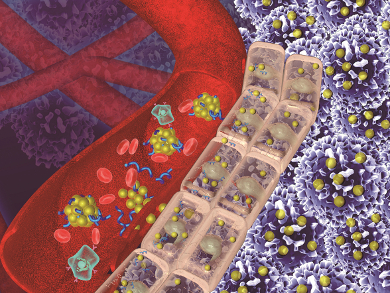Nanodrugs for anticancer treatment can be stopped by a series of physiological barriers before achieving their intended therapeutic effect. Weihong Tan, Hunan University, China, Shanghai Jiao Tong University, China, and University of Florida, Gainesville, USA, and colleagues have developed a size-controllable and transformable “stealth” nanodrug based on multiple host-guest interactions.
The nanodrug is prepared by assembling three modules: First, a poly(amidoamine) (PAMAM) dendrimer is loaded with the anticancer drug doxorubicin (Dox). Secondly, the dendrimer is coated with adamantane (Ad)-modified chimera peptides, which consist of nuclear location peptides (NLS) and matrix metalloproteinase-2 (MMP-2)-responsive peptides. Finally, a β-cyclodextrin polymer and Ad-modified CD47 peptides are added. CD-47 acts as a “don’t eat me” signal to macrophages of the immune system. The final smart nanodrug forms by self-assembly.
The nanodrug can efficiently overcome multiple biological barriers. When it is near a tumor (pictured), the hybrid drug disassembles into smaller components (DOX/PAMAM‐NLS), which enter the tumor cells. This disassembly is caused by a reaction to MMP-2, which has a higher concentration near tumors. The nanodrug, thus, successfully overcomes drug resistance. This study provides a promising strategy for designing smart and efficient nanodrugs to treat cancers.
- Smart Nanodrug with Nuclear Localization Sequences in the Presence of MMP-2 To Overcome Biobarriers and Drug Resistance,
Liuting Mo, Zilong Zhao, Xiaoxiao Hu, Xuan Yu, Yongbo Peng, Hui Liu, Mengyi Xiong, Ting Fu, Ying Jiang, Xiaobing Zhang, Weihong Tan,
Chem. Eur. J. 2019, 25, 1895–1900.
https://doi.org/10.1002/chem.201805107



